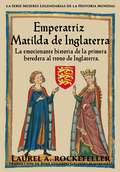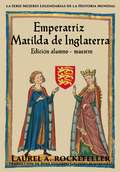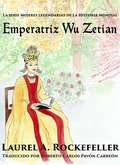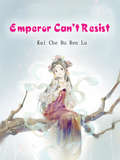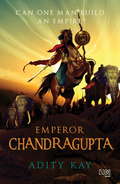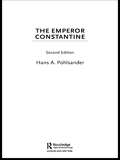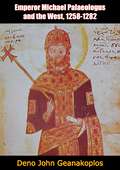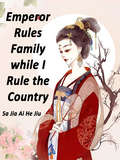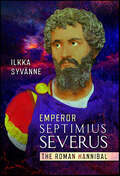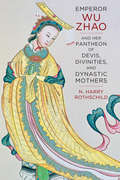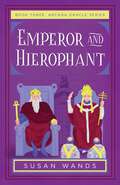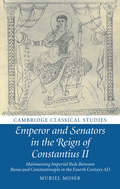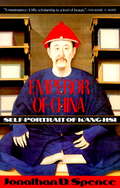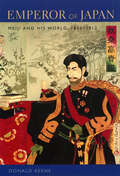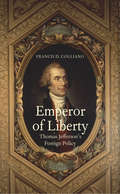- Table View
- List View
Emperatriz Matilda de Inglaterra
by Laurel A. Rockefeller¡La leona rugiente de Inglaterra! Nacida en 1102 del rey Enrique I de Inglaterra y la reina Matilda de Escocia, la herencia real única de Matilda, normanda, sajona y escocesa fue destinada a unificar a una Inglaterra todavía dividida por las conquistas de su abuelo en 1066. Cuando en 1120, el Desastre del Barco Blanco la hizo la única hija sobreviviente de sus padres y Matilda se volvió la heredera al trono inglés en un tiempo en el que el viejo Witan sajón y no la voluntad del rey decidían la sucesión. Descubre la verdadera historia de la primera mujer en reclamar el trono de Inglaterra por su propio derecho e inspírate. Incluye el árbol genealógico de Matilda, una línea del tiempo detallada y lecturas sugeridas para que puedas seguir aprendiendo.
Emperatriz Matilda de Inglaterra: Edición Alumno - Maestro (Mujeres Legendarias de la Historia Mundial #7)
by Laurel A. Rockefeller¡La leona rugiente de Inglaterra! Nacida en 1102 del rey Enrique I de Inglaterra y la reina Matilda de Escocia, la herencia real única de Matilda, normanda, sajona y escocesa fue destinada a unificar a una Inglaterra todavía dividida por las conquistas de su abuelo en 1066. Cuando en 1120, el Desastre del Barco Blanco la hizo la única hija sobreviviente de sus padres y Matilda se volvió la heredera al trono inglés en un tiempo en el que el viejo Witan sajón y no la voluntad del rey decidían la sucesión. Descubre la verdadera historia de la primera mujer en reclamar el trono de Inglaterra por su propio derecho e inspírate. La edición alumno-maestro contiene diferentes acertijos y preguntas a manera de guía de estudio después de cada capítulo, además de una detallada línea del tiempo y una extensa lista de lecturas sugeridas.
Emperatriz Wǔ Zétiān
by Roberto Carlos Pavón Carreón Laurel A. Rockefeller¡La mujer más odiada en la historia de China! Viaje en el tiempo más de mil años y conozca al primer y único emperador femenino de China. Nacida Wǔ Zhào, recibió el título de su reinado como "Zétiān" pocas semanas antes de su muerte en el año 705 de nuestra era. Fue la hija no deseada del Canciller Wǔ Shì Huo: demasiado brillante, demasiado educada, y demasiado políticamente centrada para fungir como una buena esposa según las contemporáneas interpretaciones de las Analectas de Confucio. ¿Puede ser de extrañar que al día de hoy ella sigue siendo la mujer más odiada en toda la historia de China y una de las más controvertidas? Explora la vida de la emperatriz Wǔ y descubre por qué el mundo es un lugar muy diferente ya que se atrevió a lo que ninguna mujer en China antes o desde entonces había soñado.
Emperor Can't Resist: Volume 1 (Volume 1 #1)
by Kai CheBuRenLuQin Buzhou had been on the battlefield for many years, but he had never seen such an undedicated assassin. Day after day, he grabbed onto his sleeves and hugged his arms, crying for him to accompany him.This was something intolerable, but Qin Buzhou's face was cold."Last night, His Majesty said that Chenqie had to go through with it, but today, he already changed his mind. As expected of a man, you can't trust his words. Hmph, chenqie is about to leave!""Yes, I'll do it alone," someone said, his expression unchanged.
Emperor Can't Resist: Volume 2 (Volume 2 #2)
by Kai CheBuRenLuQin Buzhou had been on the battlefield for many years, but he had never seen such an undedicated assassin. Day after day, he grabbed onto his sleeves and hugged his arms, crying for him to accompany him.This was something intolerable, but Qin Buzhou's face was cold."Last night, His Majesty said that Chenqie had to go through with it, but today, he already changed his mind. As expected of a man, you can't trust his words. Hmph, chenqie is about to leave!""Yes, I'll do it alone," someone said, his expression unchanged.
Emperor Can't Resist: Volume 3 (Volume 3 #3)
by Kai CheBuRenLuQin Buzhou had been on the battlefield for many years, but he had never seen such an undedicated assassin. Day after day, he grabbed onto his sleeves and hugged his arms, crying for him to accompany him.This was something intolerable, but Qin Buzhou's face was cold."Last night, His Majesty said that Chenqie had to go through with it, but today, he already changed his mind. As expected of a man, you can't trust his words. Hmph, chenqie is about to leave!""Yes, I'll do it alone," someone said, his expression unchanged.
Emperor Can't Resist: Volume 4 (Volume 4 #4)
by Kai CheBuRenLuQin Buzhou had been on the battlefield for many years, but he had never seen such an undedicated assassin. Day after day, he grabbed onto his sleeves and hugged his arms, crying for him to accompany him.This was something intolerable, but Qin Buzhou's face was cold."Last night, His Majesty said that Chenqie had to go through with it, but today, he already changed his mind. As expected of a man, you can't trust his words. Hmph, chenqie is about to leave!""Yes, I'll do it alone," someone said, his expression unchanged.
Emperor Can't Resist: Volume 5 (Volume 5 #5)
by Kai CheBuRenLuQin Buzhou had been on the battlefield for many years, but he had never seen such an undedicated assassin. Day after day, he grabbed onto his sleeves and hugged his arms, crying for him to accompany him.This was something intolerable, but Qin Buzhou's face was cold."Last night, His Majesty said that Chenqie had to go through with it, but today, he already changed his mind. As expected of a man, you can't trust his words. Hmph, chenqie is about to leave!""Yes, I'll do it alone," someone said, his expression unchanged.
Emperor Chandragupta
by Adity KayBecoming an emperor is not easy, especially when there are enemies everywhere and no one you can trust India, third century BCE. A land ruled by powerful dynasties, each fighting for supremacy over the other, unaware that a conqueror from Greece has arrived at the country?s doorstep in a bid to establish his dominion over the entire known world. In the east, the Magadhan empire is ruled by the Nandas, a clan driven by a limitless hunger for power and given to violence and abuse. From the embers of their lust and avarice a boy is born ? a boy named Moriya, raised by a tribe of peacock-tamers and oblivious of the legacy that is rightfully his...until the day he is sought out by Chanakya, a wily political strategist looking for vengeance against the ruthless rulers of Magadha. Under the training and tutelage of his shrewd adviser, the tentative young man, now christened Chandragupta, makes his way across the vast plains of Bharatvarsha to meet the famed invader Alexander and build an army of his own. But being a warrior prince, he finds, comes at a heavy price ? of trust and loyalty and perhaps even his life? This is the story of a youth who must battle supreme odds ? both within and without ? to fulfil his destiny as one of the greatest emperors the world has ever known. This is the story of Chandragupta Maurya.
Emperor Constantine
by Hans A. PohlsanderFirst published in 2004. Routledge is an imprint of Taylor & Francis, an informa company.
Emperor Huizong
by Patricia Buckley EbreyChina was the most advanced country in the world when Huizong ascended the throne in 1100 CE. In his eventful twenty-six-year reign, the artistically gifted emperor guided the Song Dynasty toward cultural greatness. Yet Huizong would be known to posterity as a political failure who lost the throne to Jurchen invaders and died their prisoner. The first comprehensive English-language biography of this important monarch, Emperor Huizong is a nuanced portrait that corrects the prevailing view of Huizong as decadent and negligent. Patricia Ebrey recasts him as a ruler genuinely ambitious--if too much so--in pursuing glory for his flourishing realm. After a rocky start trying to overcome political animosities at court, Huizong turned his attention to the good he could do. He greatly expanded the court's charitable ventures, founding schools, hospitals, orphanages, and paupers' cemeteries. An accomplished artist, he surrounded himself with outstanding poets, painters, and musicians and built palaces, temples, and gardens of unsurpassed splendor. What is often overlooked, Ebrey points out, is the importance of religious Daoism in Huizong's understanding of his role. He treated Daoist spiritual masters with great deference, wrote scriptural commentaries, and urged his subjects to adopt his beliefs and practices. This devotion to the Daoist vision of sacred kingship eventually alienated the Confucian mainstream and compromised his ability to govern. Readers will welcome this lively biography, which adds new dimensions to our understanding of a passionate and paradoxical ruler who, so many centuries later, continues to inspire both admiration and disapproval.
Emperor Michael Palaeologus and the West, 1258-1282: A Study in Byzantine-Latin Relations
by Deno John GeanakoplosOn Easter Monday, 1282, the bells of Santo Spirito summoned the faithful of Palermo to Vespers. But what began as a call to worship ended in revolution for the Sicilians, victory for Aragon, and the collapse of a vast coalition to restore Western rule over Constantinople. Byzantium was saved from a second occupation by the Latins.This book examines the relations between Greeks and Latins, Eastern and Western Christendom, during the reign of the Byzantine Emperor Michael VIII Palaeologus (1258-1282). The investigation focuses on the career of the Emperor from the years immediately preceding his recovery of Constantinople from the Latins in 1261 to the climax of his struggle against the West in the celebrated Sicilian Vespers of 1282. Virtually every facet of Byzantine-Western relations in the later Middle Ages is reflected in Michael’s reign, for, as will be seen, restoration of Greek rule after a half-century of alien occupation did not arrest the penetration of Latin influence within the Empire. And, externally, it excited the hostility of an aggressive West, eager to reassert its authority in Byzantium. Michael was therefore faced with a succession of diverse problems demanding almost immediate solution at his hands. It was his ability to cope with these difficulties, when failure would have resulted not only in Western political domination but, possibly, even in realization of the basic Byzantine fear—Latinization of the Greek people —that marks his reign as crucial for the subsequent history of East and West.Central to Michael’s diplomacy was his aim of appeasing the papacy, still near the pinnacle of its power, which alone could save the Greek Empire from Western designs. Thus was signed at Lyons the controversial ecclesiastical union with Rome, which resulted in the establishment of a kind of papal protectorate over Constantinople and, in effect, the tying of Byzantium to the Western political system.
Emperor Rules Family while I Rule the Country: Volume 1 (Volume 1 #1)
by Sa JiaAiHeJiuafter battling on the battlefield for so many years zhou le ping had suffered a grievous injury and returned victorious he had an ugly expression on his face that made people feel disgusted with him since the bamboo horse emperor had married his best friend she had no choice but to step down as his official zhu guanlian was a doctor who had been ordered to help her heal not only was the adonis skilled in medicine he could also help her with her plans at critical moments he was also very active in parrying the blade zhou le ping i suspect that you are plotting against me zhu kangliang would you mind looking at yourself in a mirror first afterwards she almost died on the battlefield only to find out that her life had been saved she actually managed to heal her face due to misfortune zhou le ping now i have sufficient evidence to suspect that you are plotting against me zhu kangliang would you please find a mirror to look at yourself first since you look like this how can i not scheme against you
Emperor Rules Family while I Rule the Country: Volume 2 (Volume 2 #2)
by Sa JiaAiHeJiuafter battling on the battlefield for so many years zhou le ping had suffered a grievous injury and returned victorious he had an ugly expression on his face that made people feel disgusted with him since the bamboo horse emperor had married his best friend she had no choice but to step down as his official zhu guanlian was a doctor who had been ordered to help her heal not only was the adonis skilled in medicine he could also help her with her plans at critical moments he was also very active in parrying the blade zhou le ping i suspect that you are plotting against me zhu kangliang would you mind looking at yourself in a mirror first afterwards she almost died on the battlefield only to find out that her life had been saved she actually managed to heal her face due to misfortune zhou le ping now i have sufficient evidence to suspect that you are plotting against me zhu kangliang would you please find a mirror to look at yourself first since you look like this how can i not scheme against you
Emperor Rules Family while I Rule the Country: Volume 3 (Volume 3 #3)
by Sa JiaAiHeJiuafter battling on the battlefield for so many years zhou le ping had suffered a grievous injury and returned victorious he had an ugly expression on his face that made people feel disgusted with him since the bamboo horse emperor had married his best friend she had no choice but to step down as his official zhu guanlian was a doctor who had been ordered to help her heal not only was the adonis skilled in medicine he could also help her with her plans at critical moments he was also very active in parrying the blade zhou le ping i suspect that you are plotting against me zhu kangliang would you mind looking at yourself in a mirror first afterwards she almost died on the battlefield only to find out that her life had been saved she actually managed to heal her face due to misfortune zhou le ping now i have sufficient evidence to suspect that you are plotting against me zhu kangliang would you please find a mirror to look at yourself first since you look like this how can i not scheme against you
Emperor Rules Family while I Rule the Country: Volume 4 (Volume 4 #4)
by Sa JiaAiHeJiuafter battling on the battlefield for so many years zhou le ping had suffered a grievous injury and returned victorious he had an ugly expression on his face that made people feel disgusted with him since the bamboo horse emperor had married his best friend she had no choice but to step down as his official zhu guanlian was a doctor who had been ordered to help her heal not only was the adonis skilled in medicine he could also help her with her plans at critical moments he was also very active in parrying the blade zhou le ping i suspect that you are plotting against me zhu kangliang would you mind looking at yourself in a mirror first afterwards she almost died on the battlefield only to find out that her life had been saved she actually managed to heal her face due to misfortune zhou le ping now i have sufficient evidence to suspect that you are plotting against me zhu kangliang would you please find a mirror to look at yourself first since you look like this how can i not scheme against you
Emperor Septimius Severus: The Roman Hannibal
by Ilkka SyvänneOne ancient source called Severus the most warlike of all men who had lived up to that moment in time. The rise of Septimius Severus to power started the dominance of the military in Roman affairs and it was because of this that Septimius’s advice for his sons was nothing less than: 'Be harmonious, enrich the soldiers, and scorn all other men!' Ilkka Syvanne explains in detail how the African Septimius Severus achieved his position, how he won his wars and battles and how he used his newly gained power to secure his family’s position. He reveals how he reformed the state and its military, and how he used these remodeled forces in wars of conquest to prove his worth as emperor to both the soldiers and the populace. This biography offers the first complete overview of the policies, events and military campaigns of Severus' reign in the fullest detail allowed by the sources. It also explains how and why these contributed to the military crisis of the third century and discusses the legacy he left for his son, Caracalla, who followed him in both his good and bad traits.
Emperor Wu Zhao and Her Pantheon of Devis, Divinities, and Dynastic Mothers
by Norman H. RothschildWu Zhao (624--705), better known as Wu Zetian or Empress Wu, is the only woman to have ruled China over the course of its 5,000-year history. How did she rise to power, and why was she never overthrown? Exploring a mystery that has confounded scholars for centuries, this multifaceted history suggests that Wu Zhao drew on China's rich pantheon of female divinities and eminent women to aid in her reign.Wu Zhao could not obtain political authority through conventional channels, but she could afford to ignore norms and tradition. Deploying language, symbol, and ideology, she harnessed the cultural resonance, maternal force, divine energy, and historical weight of Buddhist devis, Confucian exemplars, Daoist immortals, and mythic goddesses, establishing legitimacy within and beyond the confines of Confucian ideology. Tapping into deep, powerful subterranean reservoirs of female power, Wu Zhao built a pantheon of female divinities carefully calibrated to meet her needs at court. Her pageant was promoted in scripted rhetoric, reinforced through poetry, celebrated in theatrical productions, and inscribed on steles. Rendered with deft political acumen and aesthetic flair, these affiliations significantly enhanced Wu Zhao's authority and cast her as the human vessel through which the pantheon's divine energy flowed. Her strategy is a model of political brilliance and proof that medieval Chinese women enjoyed a more complex social status than previously known.
Emperor Wu Zhao and Her Pantheon of Devis, Divinities, and Dynastic Mothers (The Sheng Yen Series in Chinese Buddhist Studies)
by N. Harry RothschildWu Zhao (624–705), better known as Wu Zetian or Empress Wu, is the only woman to have ruled China as emperor over the course of its 5,000-year history. How did she—in a predominantly patriarchal and androcentric society—ascend the dragon throne? Exploring a mystery that has confounded scholars for centuries, this multifaceted history suggests that China's rich pantheon of female divinities and eminent women played an integral part in the construction of Wu Zhao's sovereignty. Wu Zhao deftly deployed language, symbol, and ideology to harness the cultural resonance, maternal force, divine energy, and historical weight of Buddhist devis, Confucian exemplars, Daoist immortals, and mythic goddesses, establishing legitimacy within and beyond the confines of Confucian ideology. Tapping into powerful subterranean reservoirs of female power, Wu Zhao built a pantheon of female divinities carefully calibrated to meet her needs at court. Her pageant was promoted in scripted rhetoric, reinforced through poetry, celebrated in theatrical productions, and inscribed on steles. Rendered with deft political acumen and aesthetic flair, these affiliations significantly enhanced Wu Zhao's authority and cast her as the human vessel through which the pantheon's divine energy flowed. Her strategy is a model of political brilliance and proof that medieval Chinese women enjoyed a more complex social status than previously known.
Emperor and Hierophant: Book Three, Arcana Oracle Series (Arcana Oracle Series)
by Susan WandsThe next installment in the thrilling Arcana Oracle series finds heroine Pamela Colman Smith kidnapped, imprisoned, and fighting to protect her tarot deck from Aleister Crowley once again.On tour with the Lyceum Theatre in Manchester, Pamela Colman Smith is kidnapped by a mysterious force. In captivity, she begins a relationship with her mute keeper, a strange creature at the beck and call of her nemesis, Aleister Crowley. Experiencing visions and visitations from other ethereal beings, Pamela works to escape her prison before Aleister harms another one of her muses over the ownership of her magical tarot deck. Meanwhile, her guardian and mentor, Bram Stoker, tries to find her as he tours with the stars of the Lyceum Theatre, Pamela&’s muses for the Magician and Empress cards. Alerted to Pamela&’s plight, Ahmed Kamal, Pamela&’s Egyptologist friend, joins Bram to come to her aid. Plotting against the mysterious forces who abducted her, Pamela must outwit and out magic Aleister, as he tries to destroy her muses and tarot deck. Learning the lessons of her Emperor and Hierophant, she must free herself and command the power manifesting from her tarot deck.
Emperor and Senators in the Reign of Constantius II: Maintaining Imperial Rule Between Rome and Constantinople in the Fourth Century AD (Cambridge Classical Studies)
by Muriel MoserIn this book, Muriel Moser investigates the relationship between the emperors Constantine I and his son Constantius II (AD 312–361) and the senators of Constantinople and Rome. She examines and contextualizes the integration of the social elites of Rome and the Eastern provinces into the imperial system and demonstrates their increased importance for the maintenance of imperial rule in response to political fragility and fragmentation. An in-depth analysis of senatorial careers and imperial legislation is combined with a detailed assessment of the political context - shared rule, the suppression of usurpations, Constantius' use of Constantine's memory. Using a wide range of literary, epigraphic, numismatic, and legal sources, some of which are as yet unpublished, this volume produces significant new readings of the history of the senates in Rome and Constantinople, of the construction of imperial rule and of historical change in Late Antiquity.
Emperor of China
by Jonathan D. SpenceA remarkable re-creation of the life of K'ang-hsi, emperor of the Manchu dynasty from 1661-1772, assembled from documents that survived his reign. Illustrations, notes, bibliography, index.
Emperor of Japan: Meiji and His World, 1852-1912
by Donald KeeneWhen Emperor Meiji began his rule, in 1867, Japan was a splintered empire, dominated by the shogun and the daimyos, who ruled over the country's more than 250 decentralized domains and who were, in the main, cut off from the outside world, staunchly antiforeign, and committed to the traditions of the past. Before long, the shogun surrendered to the emperor, a new constitution was adopted, and Japan emerged as a modern, industrialized state. Despite the length of his reign, little has been written about the strangely obscured figure of Meiji himself, the first emperor ever to meet a European. Most historians discuss the period that takes his name while barely mentioning the man, assuming that he had no real involvement in affairs of state. Even Japanese who believe Meiji to have been their nation's greatest ruler may have trouble recalling a single personal accomplishment that might account for such a glorious reputation. Renowned Japan scholar Donald Keene sifts the available evidence to present a rich portrait not only of Meiji but also of rapid and sometimes violent change during this pivotal period in Japan's history. In this vivid and engrossing biography, we move with the emperor through his early, traditional education; join in the formal processions that acquainted the young emperor with his country and its people; observe his behavior in court, his marriage, and his relationships with various consorts; and follow his maturation into a "Confucian" sovereign dedicated to simplicity, frugality, and hard work. Later, during Japan's wars with China and Russia, we witness Meiji's struggle to reconcile his personal commitment to peace and his nation's increasingly militarized experience of modernization. Emperor of Japan conveys in sparkling prose the complexity of the man and offers an unrivaled portrait of Japan in a period of unique interest.
Emperor of Japan: Meiji and His World, 1852–1912
by Donald KeeneThe renowned Japanese scholar &“brings us as close to the inner life of the Meiji emperor as we are ever likely to get&” (The New York Times Book Review). When Emperor Meiji began his rule in 1867, Japan was a splintered empire dominated by the shogun and the daimyos, cut off from the outside world, staunchly antiforeign, and committed to the traditions of the past. Before long, the shogun surrendered to the emperor, a new constitution was adopted, and Japan emerged as a modern, industrialized state. Despite the length of his reign, little has been written about the strangely obscured figure of Meiji himself, the first emperor ever to meet a European. But now, Donald Keene sifts the available evidence to present a rich portrait not only of Meiji but also of rapid and sometimes violent change during this pivotal period in Japan&’s history. In this vivid and engrossing biography, we move with the emperor through his early, traditional education; join in the formal processions that acquainted the young emperor with his country and its people; observe his behavior in court, his marriage, and his relationships with various consorts; and follow his maturation into a &“Confucian&” sovereign dedicated to simplicity, frugality, and hard work. Later, during Japan&’s wars with China and Russia, we witness Meiji&’s struggle to reconcile his personal commitment to peace and his nation&’s increasingly militarized experience of modernization. Emperor of Japan conveys in sparkling prose the complexity of the man and offers an unrivaled portrait of Japan in a period of unique interest. &“Utterly brilliant . . . the best history in English of the emergence of modern Japan.&”—Los Angeles Times
Emperor of Liberty
by Francis D. CoglianoThis book, the first in decades to closely examine Thomas Jefferson’s foreign policy, offers a compelling reinterpretation of his attitudes and accomplishments as a statesman during America’s early nationhood. Beginning with Jefferson’s disastrous stint as wartime governor of Virginia during the American Revolution, and proceeding to his later experiences as a diplomat in France, Secretary of State, and U. S. Vice President, historian Francis Cogliano considers how these varied assignments shaped Jefferson’s thinking about international relations. The author then addresses Jefferson’s two terms as President#151;his goals, the means he employed to achieve them, and his final record as a statesman. Cogliano documents the evolution of Jefferson’s attitudes toward the use of force and the disposition of state power. He argues that Jefferson, although idealistic in the ends he sought to achieve, was pragmatic in the means he employed. Contrary to received wisdom, Jefferson was comfortable using deadly force when he deemed it necessary and was consistent in his foreign policy ends#151;prioritizing defense of the American republic above all else. His failures as a statesman were, more often than not, the result of circumstances beyond his control, notably the weakness of the fledgling American republic in a world of warring empires.
